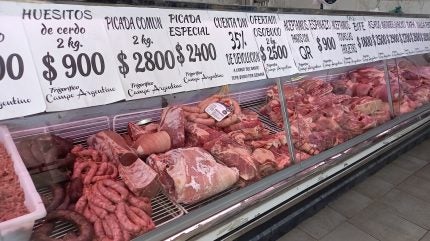
The decline in purchasing power in Argentina has led to the steepest drop in the country’s beef consumption in 30 years.
According to data from the Argentine Chamber of Meats and Derivatives Industry and Commerce (CICCRA), consumption in the first quarter of the year stood at 499,700 tons, a 17.6% drop from the same quarter in 2023.
It was the largest fall recorded by CICCRA for any quarter in three decades.
In March alone, per capita beef consumption in Argentina was 42.6kg, 18.5% below the same month in 2023.
Miguel Schiariti, the president of CICCRA, told Just Food the fall in the value of salaries amid Argentina’s soaring inflation was central to the decline.
However, he noted how the figures for the first quarter of 2023 were affected by a drought that had led meat companies to move cattle into feedlots early and increase slaughtering.
Schiariti said the move led to an over-supply of beef on the market, meaning prices in the first ten months of 2023 did not keep pace with inflation. Therefore, during that period, consumers also ate more beef, taking per capita consumption to more than 52kg.
“This is also why the fall in this last quarter was so large. Without the oversupply from last year’s drought, consumption per capita would have dropped by less than eight kilos a year instead of ten,” Schiariti added.
In March, the monthly rate for general inflation in Argentina stood at 11%, contributing to a rise of more than 51% versus December and a leap of 287.9% over the previous 12 months, according to official statistics agency INDEC.
On the other hand, general food and non-alcoholic beverages prices increased 10.5% in March compared to February, by 48.9% versus December and by 308.3% over the 12-month period.
In the case of beef, prices increased 9.5% against February and jumped 278% since March 2023, below the level of general food inflation, according to a CICCRA report.
When looking at the main cuts, the average price of common minced meat multiplied by four in twelve months, shoulder meat prices leapt 287.5% and rump prices rose 271.6%. Hamburger pack prices increased by 276.2% annually.
Schiariti called on the Argentinian government to review export fees to increase the sector’s competitiveness and help accelerate the recovery of cattle numbers through specific credit lines.
“What the meat and cattle sector needs is something the current government is already doing and that is not intervening in meat production or export,” Schiariti said. “Accelerating the recovery of the number of cows lost during the drought would increase production for domestic and foreign markets. And, when meat exports increase, there’s always cuts that remain in the domestic market at lower prices, so local prices would not increase as much, allowing people to consume beef again”.



